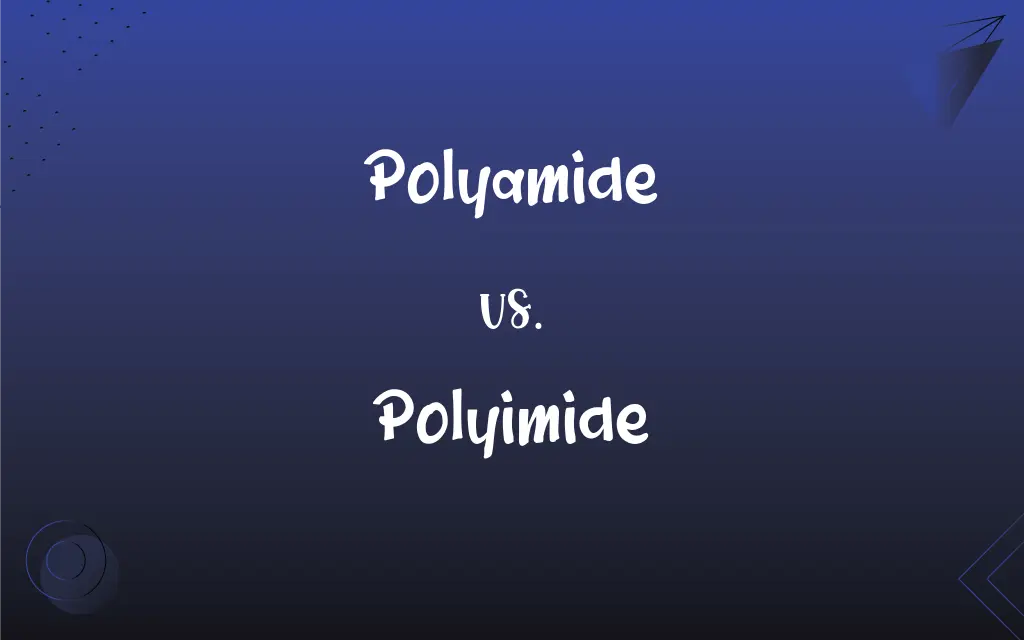Polyamide vs. Polyimide: What's the Difference?
Edited by Aimie Carlson || By Harlon Moss || Updated on November 13, 2023
Polyamide is a polymer containing amide bonds, commonly used in textiles, while polyimide is a high-performance polymer with imide linkages, often used in electronics.

Key Differences
Polyamide, consisting of repeating units linked by amide bonds, is a versatile polymer used in various applications. Polyimides, distinguished by imide linkages, are known for their remarkable thermal stability and chemical resistance. Due to the amide linkages, polyamides are often flexible and have good mechanical properties, making them popular in the manufacture of textiles like nylon. Contrarily, polyimides are used in areas requiring high-temperature resistance, such as in aerospace and electronics.
While polyamides may absorb moisture due to the nature of the amide linkage, polyimides resist moisture and maintain their properties even at elevated temperatures. Polyamides can be found in everyday products like clothing, ropes, and automotive parts, highlighting their broad utility and wear resistance. Polyimides, given their specialized properties, can be seen in items like insulating films in electronics or as protective coatings on industrial tools.
It's intriguing to note that while both polyamide and polyimide share similar sounding names and both are polymers, their chemical structures, properties, and applications can be quite different. To simplify, polyamides are more common in daily consumer products, whereas polyimides are often reserved for specialized high-performance applications.
Comparison Chart
Chemical Linkage
Contains amide bonds.
Contains imide linkages.
Common Uses
Textiles, ropes, automotive parts.
Electronics, aerospace, industrial coatings.
ADVERTISEMENT
Moisture Absorption
Can absorb moisture.
Generally moisture-resistant.
Temperature Resistance
Good, but can be affected at very high temperatures.
Excellent even at elevated temperatures.
Presence in Everyday Products
Commonly found (e.g., nylon).
Less common, specialized use.
Polyamide and Polyimide Definitions
Polyamide
A polymer containing amide bonds.
Nylon is a widely recognized polyamide used in clothing.
Polyimide
A polymer containing imide linkages.
Polyimide films are vital in many electronic applications.
ADVERTISEMENT
Polyamide
Polymer resulting from the polymerization of a monomer containing amine and acid groups.
The resulting polyamide displayed resilience against wear.
Polyimide
A high-performance polymer often used in aerospace.
Polyimide materials were selected for their durability in extreme conditions.
Polyamide
A material popular in textile manufacturing.
The polyamide fabric was both strong and flexible.
Polyimide
Known for exceptional thermal stability.
The polyimide coating could withstand high temperatures without degrading.
Polyamide
Known for its wear resistance in many applications.
The polyamide ropes had a high tensile strength.
Polyimide
Often utilized for its insulating properties.
The polyimide insulation ensured the wire could function optimally.
Polyamide
A substance commonly used in automotive parts.
The polyamide components contributed to the vehicle's durability.
Polyimide
Resistant to various chemicals.
The polyimide surface remained unaffected by the corrosive agent.
Polyamide
A polymer containing repeated amide groups, as in various kinds of nylon.
Polyimide
A synthetic polymer, containing repeating imide groups, that is resistant to high temperatures, wear, and corrosion, used primarily as a coating or film.
Polyamide
(chemistry) Any of a range of polymers containing amide (or peptide) repeat units; examples include proteins and nylon.
Polyimide
(chemistry) Any polymer whose monomers are imides; used to make high-temperature resins
Polyamide
A polymer containing repeated amide groups
FAQs
Why are polyimides preferred in aerospace?
They have excellent thermal stability, making them suitable for extreme conditions.
Are polyamides suitable for outdoor gear?
Yes, due to their wear resistance, polyamides like nylon are used in outdoor gear.
How do polyimides react to chemicals?
Polyimides generally display strong resistance to a wide range of chemicals.
Are polyamide and polyimide the same?
No, polyamide contains amide bonds and is used in textiles, while polyimide has imide linkages and is used in electronics.
Are all nylons polyamides?
Yes, nylon is a type of polyamide.
What gives polyamide its flexibility?
The amide linkages in polyamide contribute to its flexibility.
What gives polyimide its temperature-resistant properties?
The chemical structure, especially the imide linkages, contributes to its temperature resistance.
What is a common product made from polyamide?
Nylon, a textile material, is a well-known polyamide.
Can polyamides absorb water?
Yes, polyamides can absorb moisture due to their amide linkage.
Can polyamides withstand high temperatures?
While they can handle elevated temperatures, polyimides are superior in very high-temperature scenarios.
What colors can polyamides be found in?
Polyamides can be dyed into various colors, especially in textile applications.
In what electronics might I find polyimide?
Polyimide is commonly used as insulating films in flexible electronics and circuit boards.
Why are polyimides used in industrial coatings?
They offer protection, especially in high-temperature environments.
Can I find polyimide in household products?
Less commonly than polyamides, but they might be present in specialized electronics or tools.
How are polyamides produced?
They result from the polymerization of a monomer containing amine and acid groups.
Are polyimides expensive?
Due to their specialized properties, polyimides can be more costly than some other polymers.
Why are polyimides chosen for electronic applications?
They offer excellent insulation, temperature resistance, and chemical stability, making them ideal for electronics.
Which is more common in daily products, polyamide or polyimide?
Polyamide is more common in everyday products.
Is polyimide a good insulator?
Yes, polyimide is often used for its excellent insulating properties.
Are all polyamides wear-resistant?
Generally, polyamides display good wear resistance, but specifics can vary based on the type and application.
About Author
Written by
Harlon MossHarlon is a seasoned quality moderator and accomplished content writer for Difference Wiki. An alumnus of the prestigious University of California, he earned his degree in Computer Science. Leveraging his academic background, Harlon brings a meticulous and informed perspective to his work, ensuring content accuracy and excellence.
Edited by
Aimie CarlsonAimie Carlson, holding a master's degree in English literature, is a fervent English language enthusiast. She lends her writing talents to Difference Wiki, a prominent website that specializes in comparisons, offering readers insightful analyses that both captivate and inform.







































































